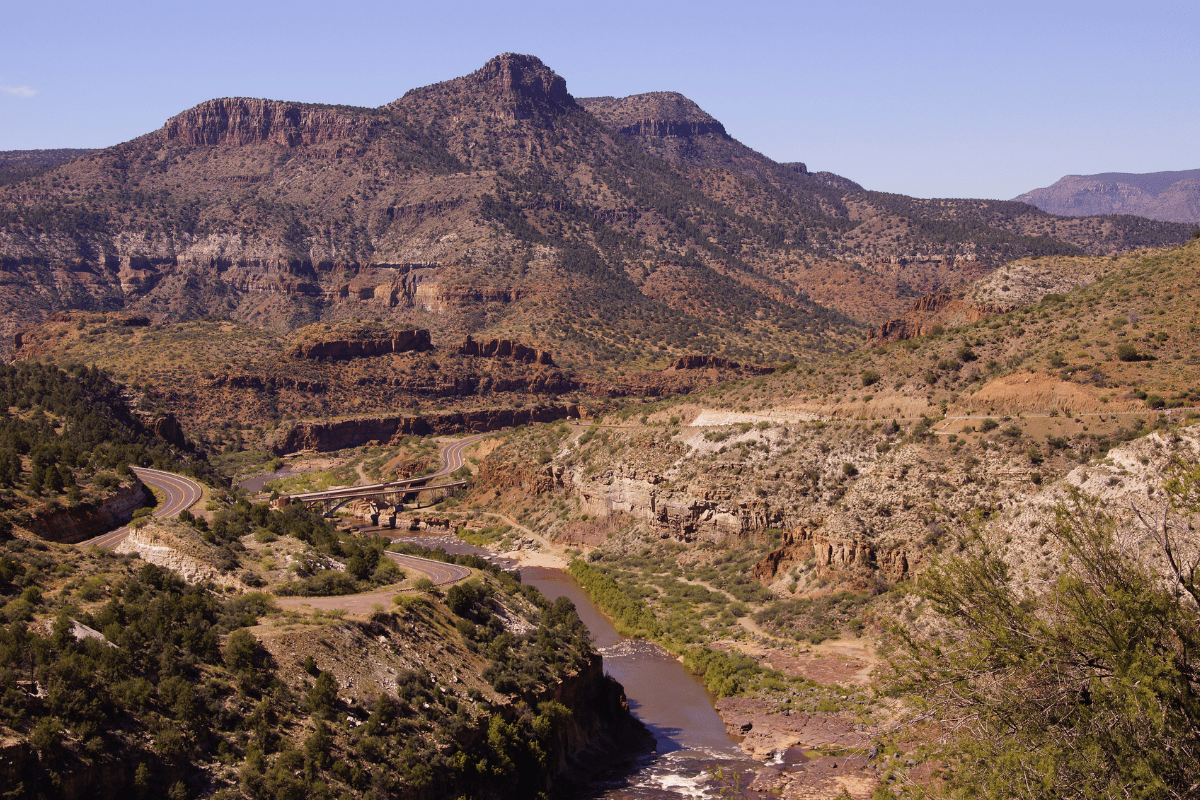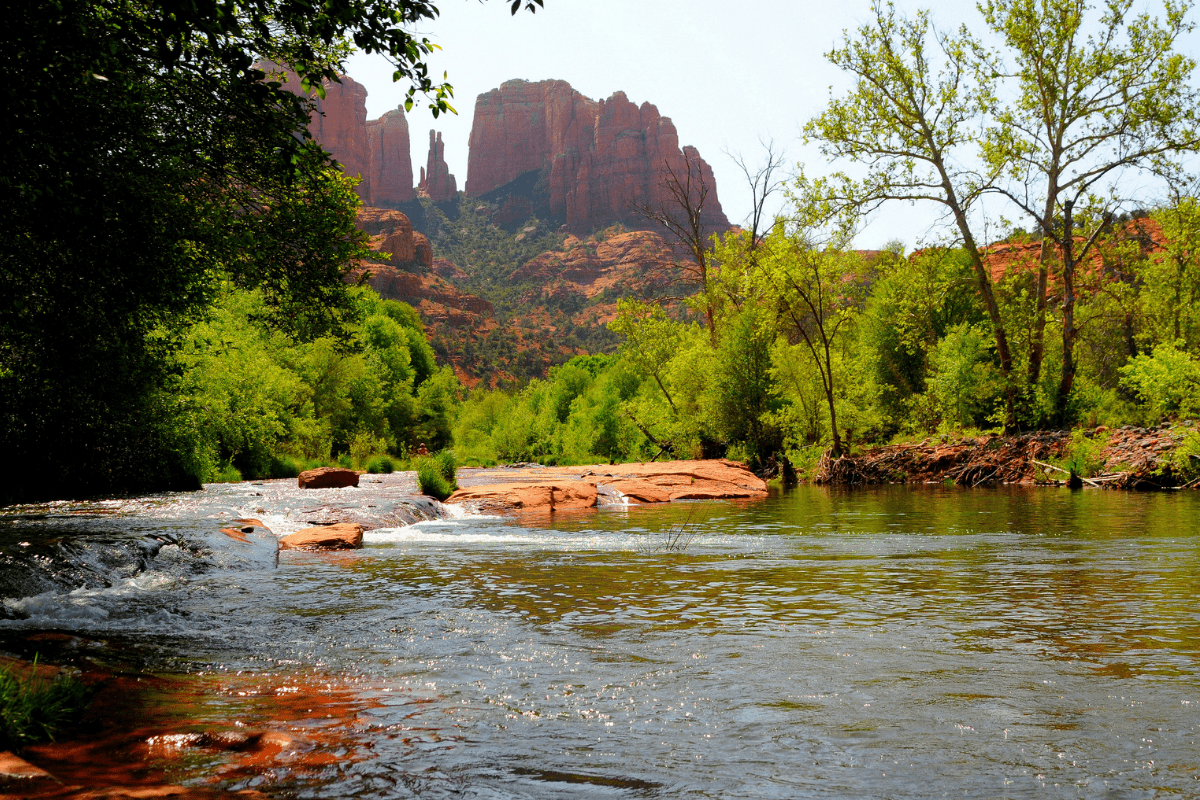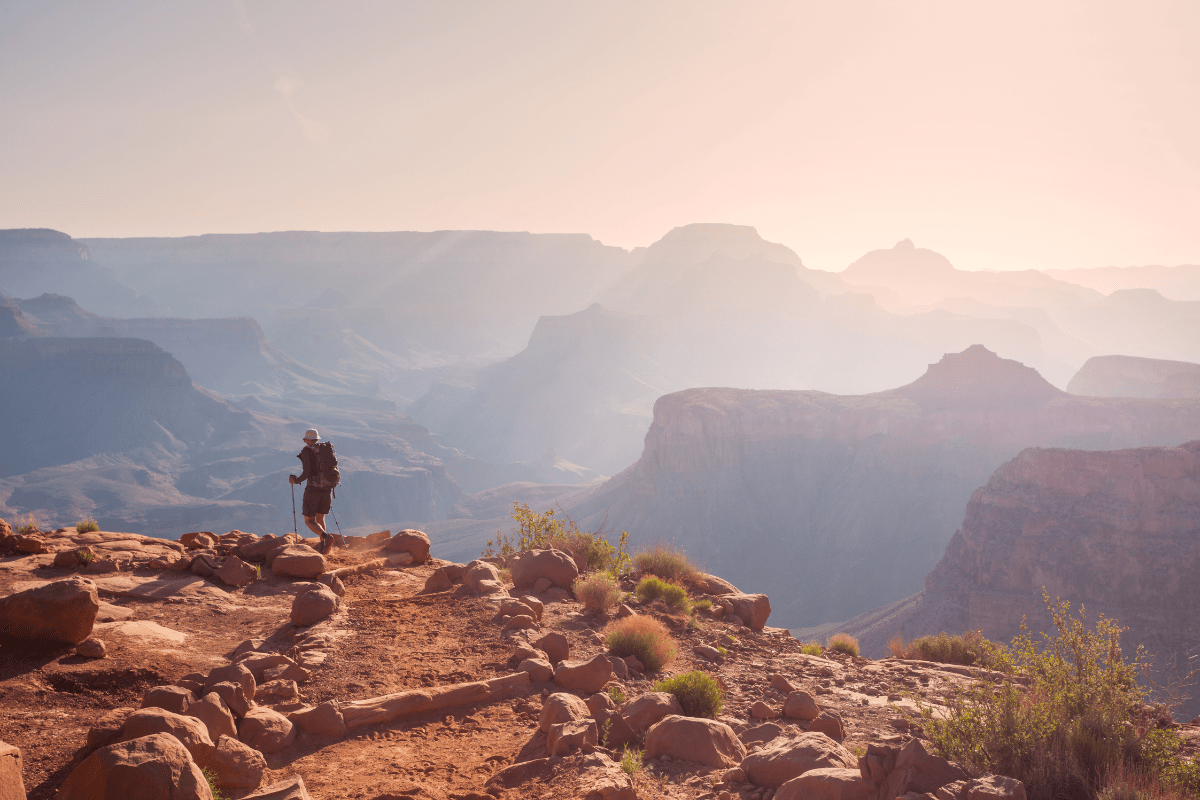Arizona attracts over 45 million visitors annually, with 6 million of them cramming into the Grand Canyon for that obligatory rim selfie. But while tourists battle for parking spots and jostle for photo angles at the famous viewpoints, the state's most remarkable destinations sit nearly empty, waiting for those willing to venture beyond the tourist trail.
The underground wonderland nobody talks about
Twenty-two miles southeast of Tucson lies a geological oddity that most visitors completely overlook. Colossal Cave Mountain Park offers something you won't find at Kartchner Caverns or most other show caves: a completely dry cave system where time essentially stopped thousands of years ago.
Unlike "living" caves where formations still grow, Colossal Cave's stalactites and flowstone formations froze in place when ancient climate changes eliminated water flow. The result? A 3.5-mile mapped wonderland (geologists estimate 39+ miles total exist) that maintains a constant 70°F temperature year-round, regardless of the scorching desert heat above.
More than just pretty rocks
The cave's human history proves equally fascinating. Hohokam peoples used these chambers from 900 to 1450 AD, and their ancient fire soot still darkens certain ceilings. Then came the Wild West era, when train robbers allegedly stashed $60,000 in stolen gold somewhere in the cave's depths. That treasure has never been found, though plenty of visitors have tried.
The Classic Tour takes you down 363 stairs and six stories underground for $24 per adult ($14 for kids). For those seeking more adventure, wild cave tours let you scramble through undeveloped passages. The surrounding 2,400-acre park includes La Posta Quemada Ranch, a working cattle operation since 1890 that adds authentic Western atmosphere without the cheesy gunfight shows.
Despite winning TripAdvisor's 2025 Travelers' Choice Award, Colossal Cave sees only moderate weekend crowds. Visit on a weekday and you might have entire chambers to yourself.
Arizona's other Grand Canyon (without the crowds)
Here's something most Arizonans know but rarely share with outsiders: the state has a second grand canyon that's arguably more dramatic than the famous one. Salt River Canyon plunges 2,000 feet through rock that's actually 1.6 billion years old… older than the Grand Canyon itself.
The best part? While six million people visit the Grand Canyon annually, Salt River Canyon sees maybe 100,000 visitors, and most just drive through without stopping. Their loss becomes your gain.
Finding the secret viewpoints
The canyon reveals itself along US-60 between Phoenix and Show Low, but knowing where to stop makes all the difference. At milepost 39.2, watch for a single palm tree marking stairs to a hidden overlook. This unmarked viewpoint delivers the full magnitude of the gorge, complete with the year-round flowing Salt River creating an oasis of green in the desert depths.
Historic mining remnants dot the canyon walls, including visible road cuts from 1930s construction efforts. The overlooks themselves cost nothing to visit, though accessing the river requires tribal permits: $20 per day for White Mountain Apache territory or $15 for San Carlos Apache lands.
Pro tip: arrive one hour before sunset when angled light illuminates the upstream canyon walls while casting shadows that emphasize the incredible depth. The copper and green mineral deposits in the cliff faces practically glow during golden hour.
The coolest cave you've never heard of
Fourteen miles northwest of Flagstaff, an unassuming forest road leads to Arizona's longest lava tube cave. This isn't your typical tourist attraction with handrails and mood lighting. Lava River Cave demands respect and proper preparation, but rewards visitors with an otherworldly underground journey.
Formed by volcanic flows from Hart Prairie roughly 700,000 years ago, this 0.75-mile tunnel maintains temperatures between 35 and 45°F year-round. When it's 100°F in Phoenix, stepping into the cave feels like entering nature's walk-in freezer.
Not for the claustrophobic
Fair warning: the entrance requires 300 feet of rock scrambling that'll have you using both hands. Once inside, you enter a world of absolute darkness. And I mean absolute… the kind where you literally cannot see your hand touching your nose.
The Forest Service emphasizes bringing three light sources per person, and that's not bureaucratic overkill. Your primary headlamp failing in that darkness would transform adventure into nightmare faster than you can say "should've brought extra batteries." Many experienced cavers also recommend helmets due to low ceiling sections that seem designed to test your skull's durability.
Despite its proximity to Flagstaff, the cave sees only 10,000 to 15,000 annual visitors compared to nearby Walnut Canyon's 150,000+. Winter road closures (December through March) limit access to those willing to ski or snowshoe in, guaranteeing solitude for the truly dedicated.
Stargazing without the tourist telescopes
Just 40 miles from Tucson's light pollution, Oracle State Park achieves something remarkable: Bortle Scale Class 2 darkness where the Milky Way actually casts shadows on the ground. Yet this International Dark Sky Park remains one of Arizona's least-visited state parks.
The park partners with Tucson Amateur Astronomy Association for free star parties where experts share high-powered telescopes and cosmic knowledge. Can't make a scheduled event? No problem. The American Avenue Trailhead offers after-hours access with advance reservations (call 520-896-2425 before 3 PM).
More than just night views
The 4,000-acre park encompasses diverse habitats supporting 150+ bird species. Fifteen miles of trails wind through grasslands and oak woodlands, while the 1930s Kannally Ranch House showcases Depression-era architecture (though it's temporarily closed for restoration).
At $12 per vehicle for night access, you're paying less than a movie ticket for front-row seats to the universe. Compare that to commercial astronomy tours charging $75+ per person, and you'll understand why locals keep this gem quiet.
Walking through time at Besh Ba Gowah
In Globe, a remarkable Salado pueblo offers authentic glimpses into prehistoric life without the gift shop gauntlet found at many archaeological sites. Besh Ba Gowah's 200 rooms housed a thriving community from 1225 to 1400 CE, and today you can walk their actual pathways and climb original ladders.
The $5 admission includes an excellent video introduction and access to artifacts displayed on-site rather than shipped to distant museums. The ethnobotanical garden showcases how indigenous peoples used native plants for food, medicine, and daily life.
What sets Besh Ba Gowah apart is its respectful, educational approach. Self-guided tours with thoughtful signage let you explore at your own pace while learning about sophisticated prehistoric societies. TripAdvisor reviewers consistently call it Globe's "best kept secret", and the modest visitor numbers mean you'll likely have entire sections to yourself.
The Wave without the lottery heartbreak
In Vermilion Cliffs National Monument, White Pocket delivers mind-bending rock formations that many photographers consider superior to the famous Wave. The crucial difference? No permits required. While The Wave limits access to 64 people daily through a soul-crushing lottery system, White Pocket welcomes all comers.
The price of solitude
Here's the catch: reaching this geological wonderland requires a 28 to 34-mile drive on unmarked sandy roads that'll test both vehicle and driver. High-clearance 4WD isn't a suggestion… it's mandatory unless you enjoy expensive recovery bills. The 2 to 2.5-hour journey from Page or Kanab features deep sand sections and rocky terrain that Google Maps often routes incorrectly.
Download offline maps before leaving civilization. Cell service vanishes quickly, and "lost in the desert" isn't a fun addition to any vacation story. For those without suitable vehicles, tours from Page ($175+) or Kanab ($229+) provide access, though self-driving allows unlimited exploration time.
The payoff justifies the effort. These 165+ million-year-old formations create an alien landscape perfect for photography at any time, though sunrise and sunset transform the rocks into glowing sculptures. Unlike The Wave's restrictions, White Pocket allows drone flying and overnight camping under exceptional dark skies. Current visitation hovers around 17,000 annually, but those numbers are climbing as Instagram discovers this photographer's paradise.
Secret viewpoints along the Mogollon Rim
While tourists crowd the official Mogollon Rim Vista Point, locals head to hidden overlooks that deliver superior views without the RV traffic. Milk Ranch Point, accessed via 28 miles of Forest Road 300 northeast of Payson, provides 360-degree panoramas spanning from Phoenix's Four Peaks to the White Mountains… over 100 miles of visibility on clear days.
Even more isolated, Promontory Butte requires a high-clearance vehicle for the final approach but rewards the effort with Arizona's darkest skies and zero light pollution. These viewpoints see fewer than 50 monthly visitors despite offering equally dramatic views as the Grand Canyon's rim.
Nature's air conditioning
The 7,600 to 7,800-foot elevation provides natural cooling, with summer temperatures rarely exceeding 85°F even as Phoenix melts above 110°F. You're standing atop the southern edge of the Colorado Plateau, where three geological provinces converge.
Forest Road 300 closes December through March, but winter rewards hardy visitors with complete solitude and increased wildlife sightings. Elk, black bear, and even mountain lions become regular observations when human traffic disappears. Camping requires free permits from the Mogollon Rim Visitor Center, though self-registration works during quiet seasons.
Arizona's most authentic ghost town (that's still alive)
Forget the tourist-trap ghost towns with their staged gunfights and overpriced sarsaparilla. Clifton preserves authentic Wild West architecture and atmosphere without admission fees or gift shop gauntlets. This working town of 3,700 residents sees fewer than 5,000 annual visitors despite featuring America's only jail carved directly into a cliff face.
The 1881 cliff jail's two cells, carved by hand into solid rock, remain open for exploration. Steep stairs lead to chambers where frontier justice played out in considerably less comfortable conditions than modern facilities. The Chase Creek Historic District preserves intact rows of brick buildings housing artists and craftspeople rather than t-shirt shops.
Real town, real prices
The recently restored Clifton Hotel offers historic lodging at $89 to $139 per night in studios that maintain period character while adding modern amenities. No chain restaurants exist, forcing visitors to experience genuine local establishments where Mexican-American fusion reflects the town's multicultural heritage.
The November Colors of Copper Art Festival represents Clifton's biggest event, drawing 400 to 500 attendees. That crowd would barely register in Sedona but transforms quiet Clifton into a vibrant cultural hub where you can actually talk to artists without shouting over tour groups.
Chiricahua's trails less traveled
While tour buses disgorge passengers at Chiricahua National Monument's scenic drive viewpoints, the park's lesser-known trails offer solitude among some of North America's most dramatic rock formations. The Natural Bridge Trail, a 5-mile round trip, leads to a spectacular rhyolite arch that few visitors ever see.
Even more secluded, the South Fork Trail winds through an environment surprisingly reminiscent of Sedona, complete with flowing water and hidden waterfalls at "The Bathtub". The park's free hiker shuttle (Thursday through Sunday, September through May) eliminates parking hassles while providing access to remote trailheads.
Sky island magic
Chiricahua's elevation range from 5,400 to 7,800 feet creates multiple climate zones within the monument. Morning hikers might start in desert grasslands and finish in pine forests, encountering 170+ bird species along the way. This sky island ecosystem supports incredible biodiversity, from coatis and javelinas to species found nowhere else in the United States.
Despite these attractions and its International Dark Sky Park designation, Chiricahua remains one of the most underrated National Park Service units. Early morning starts guarantee complete solitude and ideal lighting for photographing the volcanic rhyolite formations.
Planning your hidden Arizona adventure
These ten destinations combined receive fewer annual visitors than the Grand Canyon sees in two weeks. Yet each offers unique experiences impossible to replicate elsewhere, from underground adventures to sky island ecosystems.
When to go (and when to avoid)
October through April provides ideal weather for most destinations, though each has specific considerations:
- Lava River Cave: Best in summer heat
- High elevation sites: Accessible as deserts grow uncomfortable
- Monsoon season (July-September): Dramatic skies but flash flood risks
- Winter: Road closures affect Mogollon Rim and Lava River Cave
Essential gear by destination type
Different adventures require different preparation:
- Cave exploration: 3 light sources, helmets recommended
- Dark sky viewing: Red lights preserve night vision
- Remote access: High-clearance vehicle, offline maps, extra water
- Archaeological sites: Sun protection, respectful attitude
The bottom line on costs
Most remarkably, these adventures remain affordable. Parking fees rarely exceed $15, many sites charge nothing, and even guided experiences cost a fraction of Grand Canyon helicopter tours. The real investment lies in time and effort… driving unmarked roads, hiking beyond pavement's end, adjusting schedules around weather and seasons.
But that investment pays dividends. In these overlooked destinations, you'll find the Arizona that residents cherish. Places where nature's artistry continues unmarred by gift shops and guardrails. Where ancient cultures' stories persist without theme park interpretation. Where darkness still reveals the universe's majesty.
The greatest discovery might be this: in avoiding crowds and seeking solitude, you don't sacrifice quality for obscurity. Instead, you gain something increasingly rare… the chance to experience profound natural and cultural wonders on your own terms, creating personal connections impossible among throngs of tourists. These hidden treasures offer not just destinations but transformations, reminding us why we travel in the first place.





